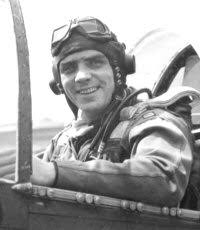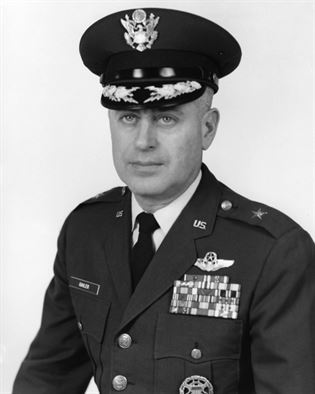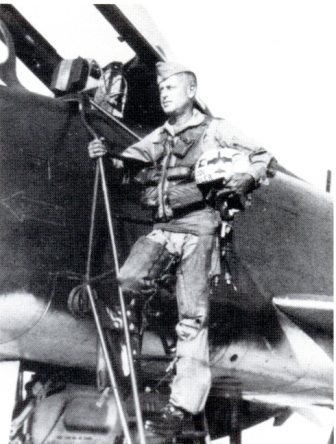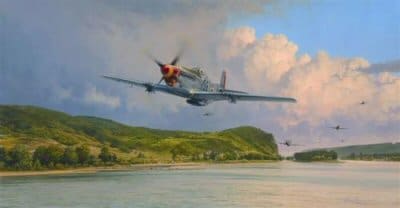SSS member Frank L. Gailer, Jr (94) Headed West 1923-2018
BGen Frank Gailer, USAF (Ret) of San Antonio, Texas, Headed West September 6, 2018, in Louisville, Colorado. He was 94.
 Frank Gailer was posted to England, joining the 357th Fighter Group at Leiston. Flying with the 363rd FS he went into combat in August 1944, and in the next few months destroyed 6 enemy aircraft before being shot down in November 1944. Captured by the Germans, he was interned in Stalag 1.
Frank Gailer was posted to England, joining the 357th Fighter Group at Leiston. Flying with the 363rd FS he went into combat in August 1944, and in the next few months destroyed 6 enemy aircraft before being shot down in November 1944. Captured by the Germans, he was interned in Stalag 1.
Air Superiority by Robert Taylor
 Frank’s last assignment was as a BGen and vice commander of Third Air Force, U.S. Air Forces in Europe. Third Air Force, with Headquarters located at South Ruislip Air Station, Middlesex, England, is primarily a tactical fighter and reconnaissance force of the U.S. Air Force which is based in Great Britain and committed to the North Atlantic Treaty Organization.
Frank’s last assignment was as a BGen and vice commander of Third Air Force, U.S. Air Forces in Europe. Third Air Force, with Headquarters located at South Ruislip Air Station, Middlesex, England, is primarily a tactical fighter and reconnaissance force of the U.S. Air Force which is based in Great Britain and committed to the North Atlantic Treaty Organization.
Frank was born in Bakersfield, Calif., in 1923. Shortly thereafter, his family moved to New York, finally settling in Great Neck, Long Island. He graduated from Staunton Military Academy, Staunton, Va., in 1941, and attended Hofstra College, Hempstead, N.Y., until June 1942. He then entered the aviation cadet program and received pilot training at Parks Air College, Garden City, Kan., and Eagle Pass, Texas, where he earned his pilot wings and commission as second lieutenant.
In September 1943 he was assigned to Columbia Army Air Base, S.C., for tactical training in the B-25 aircraft and in February 1944 was transferred to P-40 training at Thomasville, Ga. In July 1944 he joined the 357th Fighter Group in England as a P-51 pilot. Flying with the 363rd Fighter Squadron, he was credited with destroying 6 1/2 enemy aircraft before he was shot down in November 1944 and interned by the Germans as a prisoner of war in Stalag One.
He returned to the United States in 1945; and until June 1946, he served as base flight operations officer at Selfridge Field, Mich. He went to the Panama Canal Zone as a squadron commander in the 6th Fighter Wing. From February 1949 until June 1954, he served as the Group operations officer and then deputy commander of the 6570th Chemical and Ordnance Test Group, Aberdeen Proving Ground, Md.
In February 1955 he was assigned the U.S. Air Force Mission to Uruguay as the jet fighter adviser. From December 1958 until June 1962 he served as chief, Latin American Missions Branch, Deputy Chief of Staff for Operations, Headquarters U.S. Air Force. From July 1962 until July 1963, he served as an action officer in the Office of the Special Assistant for Military Assistance Affairs, with the Organization of the Joint Chiefs of Staff.
He attended the National War College, Washington, D.C., graduating in June 1964. From there he served as deputy commander for operations, 3640th Pilot Training Wing, Laredo Air Force Base, Texas. In January 1966 he was assigned as the first commander of the newly organized 3630th Flying Training Wing, Sheppard Air Force Base, Texas. From August 1967 to July 1968, he was assigned to the National War College as a faculty member.
 In September 1968 he assumed command of the 35th Tactical Fighter Wing at Phan Rang Air Base, Vietnam.
In September 1968 he assumed command of the 35th Tactical Fighter Wing at Phan Rang Air Base, Vietnam.
Frank arrived at Royal Air Force Lakenheath, England, in September 1969 as commander of the 48th Tactical Fighter Wing. He was named vice commander of the Third Air Force with headquarters at South Ruislip Air Station, Middlesex, England, in February 1970.
Frank is a member of the American Fighter Aces Association, Pi Sigma Alpha, (the National Political Sciences Honor Society) and holds a bachelor of science degree, 1953, and a master of arts degree in international affairs, 1960, from the University of Maryland. He has also completed an additional 30 semester hours of study toward his doctorate of philosophy degree. His article “USAF Mission in Latin America,” was published in the Air University Quarterly Review, fall 1961.
He is a command pilot with more than 6,100 flying hours, including more than 2,000 hours in both conventional and jet fighter aircraft, and more than 500 combat hours. He completed 235 combat missions in the F-100 Super Sabre over the Republic of Vietnam. His military decorations include the Legion of Merit with oak leaf cluster, the Distinguished Flying Cross with oak leaf cluster, the Air Medal with 20 oak leaf clusters, the Joint Service Commendation Medal, Air Force Commendation Medal, Army Commendation Medal, Purple Heart, Air Force Outstanding Unit Award Ribbon, and the Vietnam Air Force Distinguished Service Order Second Class from the government of the Republic of Vietnam.

